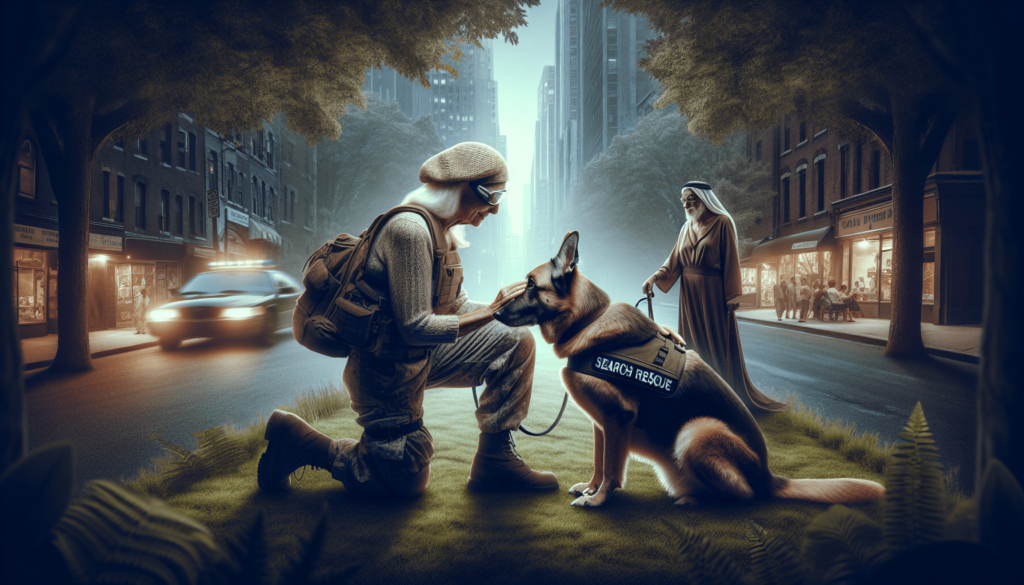
In the article “How Do Animals Help Keep People Safe?”, you will discover the incredible ways in which animals play a vital role in ensuring our safety. By engaging your community in animal protection, you can raise awareness and bring about meaningful change. This article will explore several strategies that you can use to mobilize your community around animal welfare issues. Get ready to be amazed by the ways animals contribute to our well-being and safety!

Assistance Animals
Assistance animals play a crucial role in providing support and companionship to individuals with various disabilities. Among the different types of assistance animals, guide dogs for the visually impaired are perhaps the most well-known. These incredible dogs assist their handlers by guiding them through their daily activities, helping them navigate obstacles, and ensuring their safety. With their exceptional training and intelligence, guide dogs become invaluable partners in enhancing the independence and freedom of visually impaired individuals.
Similar to guide dogs, hearing dogs for the deaf offer invaluable support to individuals with hearing impairments. These specially trained dogs alert their handlers to various sounds such as doorbells, fire alarms, and approaching vehicles. By providing this auditory assistance, hearing dogs enable their owners to be more aware of their surroundings and overcome the challenges posed by hearing loss.
Service dogs cater to the needs of individuals with a wide range of disabilities, including physical, psychiatric, and developmental conditions. These highly trained animals are trained to perform specific tasks such as retrieving items, opening doors, pulling wheelchairs, and providing deep pressure therapy for individuals with anxiety or autism. Service dogs not only enhance the independence and quality of life for their handlers but also provide a constant source of companionship and emotional support.
Search and Rescue Animals
Search and rescue animals have a unique and vital role in locating missing individuals in difficult and life-threatening situations. Tracking dogs are trained to follow scent trails and are invaluable assets in locating missing persons in wilderness environments. Their incredible sense of smell, combined with their agility, allows them to traverse challenging terrains and find individuals who may otherwise be difficult to locate.
Avalanche dogs are specifically trained to locate individuals buried under snow due to avalanches. These highly skilled dogs can detect human scent even under several feet of snow, significantly increasing the chances of finding and rescuing victims quickly. Their training and dedication enable search and rescue teams to respond effectively in avalanche situations, saving lives in high-risk scenarios.
Water rescue dogs are specially trained to assist in locating and rescuing individuals in aquatic environments. These dogs possess excellent swimming abilities and are trained to navigate the water while searching for people in distress. Water rescue dogs are a crucial part of teams responding to boating accidents, drownings, and other water-related emergencies, providing a glimmer of hope in dire circumstances.
Police and Military Animals
Police dogs, commonly known as K-9 officers, are highly trained canines that work alongside law enforcement agencies to assist with various tasks. These dogs are equipped with exceptional abilities, such as tracking suspects, detecting narcotics and explosives, and apprehending individuals when necessary. Their incredible sense of smell and agility make them indispensable assets in crime-solving and ensuring public safety.
Alongside their human counterparts, military working dogs serve in various capacities to protect military bases, personnel, and assets. These highly trained dogs perform tasks such as bomb detection, patrolling, tracking, and apprehending suspects. Their exceptional loyalty, courage, and discipline make them valuable members of military operations, contributing to mission success and the safety of military personnel.
Therapy Animals
Therapy animals offer comfort, emotional support, and companionship to individuals in a therapeutic setting. Therapy dogs, in particular, have been widely used in various healthcare facilities, including hospitals, nursing homes, and rehabilitation centers. These dogs have a gentle and calm demeanor, providing emotional support to patients and bringing joy to their lives. By engaging in activities such as petting, playing, and spending time with therapy dogs, individuals can experience improvements in their mental, emotional, and physical well-being.
Therapy horses, also known as equine-assisted therapy, have been proven to be highly beneficial in treating individuals with physical and mental health issues. The rhythmic motion of riding a horse stimulates sensory integration, which can aid individuals in improving their balance, coordination, and muscle strength. Additionally, interacting with horses can promote emotional healing and provide a calming effect, making equine-assisted therapy a unique and impactful form of treatment.

Detecting Diseases and Medical Conditions
Certain animals possess incredible abilities to detect diseases and medical conditions, making them invaluable allies in early detection and prevention. Cancer-sniffing dogs, for instance, have been trained to detect specific volatile organic compounds released by cancer cells. These incredible dogs can detect the presence of cancer in breath, urine, and even small tissue samples, potentially contributing to earlier diagnosis and treatment.
Diabetic alert dogs are trained to detect changes in blood sugar levels in individuals with diabetes. By using their incredible sense of smell, these dogs can sense fluctuations in chemical compounds produced by the body during hypoglycemia or hyperglycemia. Their early detection of such changes enables individuals to take necessary actions to prevent complications and maintain better control of their diabetes.
Seizure alert dogs are specially trained to detect impending seizures in individuals with epilepsy. These dogs can pick up on pre-seizure cues such as changes in scent, behavior, or body language. By alerting their handlers or surrounding individuals to an impending seizure, these dogs provide valuable support and increase the safety and well-being of individuals living with epilepsy.
Animal-Assisted Interventions
Animal-assisted interventions involve the inclusion of animals in therapeutic or educational settings to help individuals overcome challenges and achieve specific goals. Equine-assisted therapy is a form of intervention that involves interactions with horses to promote emotional, physical, and cognitive growth. This therapy can be particularly beneficial for individuals with autism spectrum disorders, post-traumatic stress disorder (PTSD), and various mental health conditions.
Dolphin-assisted therapy utilizes the gentle and intelligent nature of dolphins to provide therapeutic benefits to individuals with physical disabilities, cognitive impairments, or emotional challenges. The positive interactions with dolphins, such as swimming, touching, and interacting, can improve muscle strength, coordination, social skills, and overall well-being. Dolphin-assisted therapy offers individuals a unique and empowering experience in a natural and nurturing environment.
Natural Disaster Prediction
It may seem astonishing, but animals have demonstrated their ability to sense and predict natural disasters, providing valuable warning signs for human safety. Dogs, for example, have shown a remarkable ability to sense impending earthquakes. While the exact mechanism is still unknown, dogs have been observed exhibiting unusual behavior or agitation before an earthquake strikes, potentially providing a crucial early warning system.
Similarly, research has shown that elephants can sense the approach of a tsunami before it becomes visible to human observers. Elephants have been observed moving to higher ground or displaying anxious behavior shortly before a tsunami occurs, indicating their remarkable ability to detect impending danger. Understanding and studying these animal behaviors could potentially contribute to the development of early warning systems for natural disasters.
Insect Control and Disease Prevention
Animals also play a significant role in insect control and disease prevention, contributing to public health and safety. Honeybees, for instance, are indispensable as pollinators, facilitating the reproduction of plants and ensuring food production. These industrious insects, through their pollination activities, help sustain ecosystems, promote biodiversity, and enhance crop yields, thereby contributing to global food security.
Rats, although often associated with negative connotations, have been utilized in detecting landmines due to their keen sense of smell. Trained rats have proven to be effective at detecting landmines by sniffing out explosive chemicals present in these deadly devices. Their ability to navigate minefields and detect even trace amounts of explosives can greatly aid in landmine clearance efforts, safeguarding human lives and facilitating post-conflict reconstruction.
Personal Safety and Security
Animals are often employed for personal safety and security purposes, helping to safeguard individuals, homes, and properties. Guard dogs, for example, provide an effective deterrent against potential intruders or threats. With their strong protective instincts, heightened senses, and rigorous training, guard dogs can alert their owners to potential dangers and, if necessary, apprehend or deter intruders, creating a safer environment.
While geese may not be the first animal that comes to mind in terms of personal safety and security, they can indeed serve as watchful protectors. Due to their loud honking and aggressive nature, watch geese are known to be highly effective at alerting their owners to potential threats. Their vigilant nature and ability to sound the alarm can deter intruders and offer an added layer of security to residential and commercial properties.
Emotional Support Animals
Emotional support animals provide comfort, companionship, and emotional stability to individuals experiencing mental health challenges. Emotional support dogs have become increasingly popular in this role due to their incredible ability to form deep emotional connections and offer unconditional love. They can provide a constant source of emotional support, reduce anxiety and stress, and offer a sense of security and belonging.
In addition to dogs, emotional support cats also offer unique benefits to individuals struggling with mental health issues. Cats have a calming presence and can bring a sense of peace and serenity to their owners. Bonding with a cat and engaging in activities such as petting and playing can create a distraction from negative thoughts and provide solace during difficult times.
In conclusion, animals play a remarkable role in keeping people safe in various capacities. From assistance animals that cater to the specific needs of individuals with disabilities to animals trained to detect diseases and provide therapy, their contributions are invaluable. Whether it’s the incredible abilities of search and rescue animals, the loyal service of police and military animals, or the comforting presence of therapy and emotional support animals, our furry and feathered friends have a lasting impact on our safety, well-being, and quality of life. Appreciating their unique abilities and acknowledging their significance fosters a deeper understanding and gratitude for the special relationship between humans and animals.







